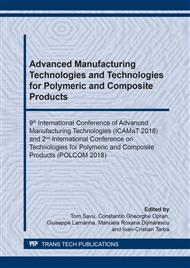[1]
J. Callaghan., A. Rosenberg., H.E. Rubash, The Adult Hip, 2nd Edition, Lippincott Williams and Wilkins, USA (2006) 123-130.
Google Scholar
[2]
FDA. 2008. Class 2 recall Durom cup, [online] Available at: http://www.accessdata.fda.gov/scripts/cdrh/cfdocs/cfres/res.cfm?id=72744 [Accessed 11/05/2017].
Google Scholar
[3]
J.V. Dollar, Comparative Analysis of Weight Bearing Surfaces in Joint Arthroplasty, The TM Journal, 3(11), (2004).
Google Scholar
[4]
B.D. Ratner., A.S. Hoffman., F.J. Schoen., J.E. Lemons, An Introduction to Materials in Medicine, 2nd Edition, California, Elsevier Academic Press: (2004) 535.
Google Scholar
[5]
H.S. Hothi.. The Impact and Deformation of Press-Fit Metal Acetabular Components, Thesis, Queen Mary University of London (2012).
Google Scholar
[6]
J. Charnley, The Bonding of Prostheses to Bone by Cement, The Journal of Bone and Joint Surgery, 46B(3) (1964) 518-529.
DOI: 10.1302/0301-620x.46b3.518
Google Scholar
[7]
J. Charnley. Surgery of the Hip Joint: Present and Future Developments, British Medical Journal, 19 (1960) 821-826.
Google Scholar
[8]
Ebied., S. Journeaux, Metal-on-Metal Hip Resurfacing, Current Orthopaedics, 16 (2002) 420-425.
DOI: 10.1054/cuor.2002.0303
Google Scholar
[9]
K. Furuya., K, M. Tsuchiya, S. Kawachi. Socket-Cup Arthroplasty, Clinical Orthopaedics and Related Research, 134 (1978) 41-44.
DOI: 10.1097/00003086-197807000-00007
Google Scholar
[10]
D. Cotoros, Analysis of Skeletal Prosthesis Component Elements at Structural Level, Metalurgia International, Volume: 15, Special Issue: 7, (2010) 116-120.
Google Scholar
[11]
S.A. Jacbosson., K. Djerf., O. Wahlstrom, Twenty-Year Results of McKee-Farrar versus Charnley Prosthesis, Clinical Orthopaedics and Related Research, 329: S60-8 (1996).
DOI: 10.1097/00003086-199608001-00006
Google Scholar
[12]
S. Mihai, V. Filip, M. Vladescu, Contributions to the improvement of the tribological behaviour of hip implant joints, Journal of Science and Arts Year 16, No. 2(35), (2016) 177-184.
Google Scholar
[13]
L.S. Pinchuk., V.I. Nikolaev., E.A. Tsvetkova., V.A. Goldade, Tribology and Biophysics of Artificial Joints, in: B.J. Briscoe (Ed.) Tribology and interface engineering series, (U.K.) (2006).
Google Scholar
[14]
E. Young, National Joint Registry for England, Wales, Northern Ireland and the Isle of Man; Annual Report, 12th; National Joint Registry: Hempstead, UK (2015).
DOI: 10.1302/3114-221625
Google Scholar
[15]
E. Ingham, J. Fisher, Biological reactions to wear debris in total joint replacement. Proc. Inst. Mech. Eng. H J. Eng. Med. 214, (2000) 21–37.
DOI: 10.1243/0954411001535219
Google Scholar
[16]
RM. Hall., A. Unsworth, Wear in retrieved Charnley acetabular sockets. Proc. Inst. Mech. Eng. H J. Eng. Med. 210, (1996) 197–207.
DOI: 10.1243/pime_proc_1996_210_413_02
Google Scholar
[17]
T.R. Green., J. Fisher., J.B. Matthews., M.H. Stone., E. Ingham, Effect of size and dose on bone resorption activity of macrophages by in vitro clinically relevant ultrahigh molecular weight polyethylene particles, J. Biomed. Mater. Res., 53 (2000) 490–497.
DOI: 10.1002/1097-4636(200009)53:5<490::aid-jbm7>3.0.co;2-7
Google Scholar
[18]
J.H. Benjamin., J. Thomas, A Tribological Assessment of Ultra High Molecular Weight Polyethylene Types GUR 1020 and GUR 1050 for Orthopedic Applications, MDPI Lubricants Academic: James E. Krzanowski (Ed.) (2016).
DOI: 10.3390/lubricants4030025
Google Scholar
[19]
Standard Test Method forWear Testing of Polymeric Materials Used in Total Joint Prostheses. ASTM F732-00; ASTM:West Conshohocken, PA, USA, 2011, p.1–11.
Google Scholar
[20]
British Standards Insitution, BS ISO 5834-2:2011. Implants for Surgery—Ultra-High-Molecular-Weight Polyethylene: Moulded Forms; British Standards Online: UK, (2011).
DOI: 10.3403/01517125
Google Scholar
[21]
S.M. Kurtz., O.K. Muratoglu., M. Evans, Advances in the processing, sterilization, and crosslinking of ultra-high molecular weight polyethylene for total joint arthroplasty. Biomaterials, 20 (1999) 1659–1688.
DOI: 10.1016/s0142-9612(99)00053-8
Google Scholar
[22]
C.N. Druga., A. Repanovici., C. Rosca., R. Necula, Design and construction of an experimental stand for total hip and knee prosthetics testing, The 6th IEEE International Conference on E-Health and Bioengineering - EHB (2017).
DOI: 10.1109/ehb.2017.7995445
Google Scholar
[23]
C. N. Druga, Contributions to the study of operation of the prosthetic elements, Thesis, Transilvania Univ. of Brasov, Faculty of Product Design and Environment, 2011, pp.177-187.
Google Scholar
[24]
ASTM International, F 1714 – 02 Standard Guide for Gravimetric Wear Assessment of Prosthetic Hip-Designs in Simulator Devices, 2002, pp.1-4.
DOI: 10.1520/f1714-96r02
Google Scholar
[25]
A.P. Harsha., T.J. Joyce., Comparative wear tests of ultra-high molecular weight polyethylene and cross-linked polyethylene. Proc. Inst. Mech. Eng. H J. Eng. Med., 227 (2013) 600–608.
DOI: 10.1177/0954411913479528
Google Scholar
[26]
V. Saikko, Performance analysis of an orthopaedic biomaterial 100-station wear test system. Proc. Inst. Mech. Eng. C J. Mech. Eng. Sci., 224 (2010) 697–701.
Google Scholar
[27]
L.A. Korduba., A. Wang, The effect of cross-shear on the wear of virgin and highly-crosslinked polyethylene, Wear, 271 (2011) 1220–1223.
DOI: 10.1016/j.wear.2011.01.039
Google Scholar
[28]
M. Turell, A. Wang, A. Bellare, Quantification of the effect of cross-path motion on the wear rate of ultra-high molecular weight polyethylene. Wear, 255 (2003) 1034–1039.
DOI: 10.1016/s0043-1648(03)00357-0
Google Scholar
[29]
D.M. Barbu, A total knee prosthesis CAD design, The 6th IEEE International Conference on E-Health and Bioengineering (2017).
Google Scholar


